String inverters are devices that convert direct current (DC) from solar panels into alternating current (AC) that can be used by appliances or fed into the grid. They are an essential component of any solar energy system, as they determine the quality and quantity of the power output. In this blog post, we will explore the advancements in string inverter technology that have made them more efficient, reliable, flexible, and cost-effective than ever before. We will also look at some real-world examples and market trends that showcase the potential of string inverters in the global solar industry. According to a recent report, the global string inverter market size attained a value of more than USD 4.03 billion in 2023. The market is further expected to grow at a CAGR of 9.0% in the forecast period of 2024-2032, to account for a value of over USD 8.73 billion by 2032.
Evolution of String Inverter Technology
String inverters have come a long way since their inception in the 1980s. Back then, they were bulky, noisy, and prone to overheating and failures. They also had low conversion efficiencies and limited features for monitoring and control. However, with the advancement of power electronics, microprocessors, and communication technologies, string inverters have undergone significant improvements in terms of design, functionality, and performance.
- One of the major technological breakthroughs that drove innovation in string inverters was the development of insulated-gate bipolar transistors (IGBTs), which are high-power switches that can handle high voltages and currents. IGBTs enabled string inverters to operate at higher frequencies and switch faster, resulting in higher conversion efficiencies and lower power losses.
- Another key development was the transition from passive to active cooling systems, which improved the thermal management and durability of string inverters. Passive cooling systems rely on natural convection and radiation to dissipate heat, which can be insufficient for high-power applications. Active cooling systems use fans, pumps, or liquid cooling to enhance heat transfer and prevent overheating. Active cooling systems also reduce the noise and vibration levels of string inverters, making them more suitable for residential and commercial settings.
- A third important advancement was the integration of digital monitoring and control capabilities, which enabled string inverters to communicate with other devices and systems, such as solar panels, energy meters, batteries, and grid operators. Digital monitoring and control capabilities allow string inverters to optimize their performance, detect and diagnose faults, provide remote access and updates, and support grid services, such as voltage and frequency regulation, reactive power compensation, and demand response.
Improved Efficiency and Performance
As a result of these technological advancements, string inverters have achieved higher levels of efficiency and performance than ever before. Efficiency refers to the ratio of the output power to the input power, and it indicates how well the string inverter converts DC to AC. Performance refers to the quality and quantity of the power output, and it depends on various factors, such as maximum power point tracking (MPPT), grid compatibility, power losses, and energy harvest.
- String inverters have achieved higher conversion efficiencies and improved MPPT algorithms, which ensure that the string inverter operates at the optimal voltage and current for the solar panels. Conversion efficiencies of string inverters can reach up to 99%, while MPPT efficiencies can exceed 99.5%. This means that string inverters can extract the maximum possible power from the solar panels under varying weather and irradiance conditions.
- String inverters have also enhanced their voltage and frequency regulation capabilities, which ensure that the power output meets the grid standards and does not cause any disturbances or instability. String inverters can adjust their output voltage and frequency according to the grid requirements, and they can also provide ancillary services, such as reactive power compensation, power factor correction, and harmonic filtering. These services help to maintain the grid voltage and frequency within acceptable ranges, and they also improve the power quality and reliability.
- String inverters have also minimized their power losses and improved their energy harvest, which increase the overall system performance and return on investment (ROI). Power losses occur due to various factors, such as resistance, leakage, switching, and shading. String inverters have reduced their power losses by using high-quality components, efficient cooling systems, and fast switching devices. They have also improved their energy harvest by using multiple MPPT inputs, which allow them to handle different string sizes and orientations, and by using shade-tolerant algorithms, which mitigate the effects of partial shading on the solar panels.
- String inverters have also improved their impact on the overall system performance and ROI, by reducing the balance of system (BOS) costs, increasing the system availability, and simplifying the system design and installation. BOS costs refer to the costs of the components and labor required for the solar system, excluding the solar panels and the inverter. String inverters have reduced the BOS costs by eliminating the need for additional components, such as transformers, combiner boxes, and DC cables. They have also increased the system availability by having lower failure rates, longer warranties, and easier maintenance and replacement. They have also simplified the system design and installation by having compact and lightweight designs, plug-and-play features, and user-friendly interfaces.
Enhanced Reliability and Durability
Another benefit of the advancements in string inverter technology is the enhanced reliability and durability of the devices. Reliability refers to the ability of the string inverter to operate without failures or malfunctions, and it is measured by the mean time between failures (MTBF) and the failure rate. Durability refers to the ability of the string inverter to withstand harsh environmental conditions, such as high temperatures, humidity, dust, and corrosion, and it is measured by the service life expectancy and the warranty period.
- String inverters have improved their reliability and durability by using robust design and construction materials, which protect them from mechanical and electrical stresses. String inverters have adopted rugged and sturdy enclosures, which can resist impacts, vibrations, and moisture. They have also used corrosion-resistant and flame-retardant materials, which can prevent rusting and fire hazards. Some string inverters have also achieved high protection ratings, such as IP65 or NEMA 4X, which indicate that they are dust-proof and water-proof.
- String inverters have also improved their reliability and durability by using advanced fault detection and protection mechanisms, which prevent damage and ensure safety. String inverters have incorporated various sensors and switches, which can monitor the input and output parameters, such as voltage, current, temperature, and frequency, and detect any abnormalities or deviations. They have also implemented various protection mechanisms, such as overvoltage, overcurrent, overtemperature, short-circuit, ground-fault, and surge protection, which can isolate and shut down the string inverter in case of any faults or hazards.
- String inverters have also improved their reliability and durability by offering extended warranties and service life expectancy, which reflect their confidence and quality. String inverters have increased their warranties from the standard 5 years to up to 25 years, depending on the manufacturer and the model. They have also increased their service life expectancy from the typical 10 years to up to 30 years, depending on the usage and the maintenance. These warranties and service life expectancy can provide peace of mind and security to the customers, and they can also reduce the total cost of ownership and increase the ROI.
- String inverters have also improved their reliability and durability by reducing their maintenance requirements and downtime, which enhance their availability and performance. String inverters have reduced their maintenance requirements by using self-cleaning and self-cooling features, which prevent dust accumulation and overheating. They have also reduced their downtime by using remote monitoring and control features, which allow for easy diagnosis and troubleshooting. Some string inverters also have modular and replaceable components, which facilitate quick and easy repairs and replacements.
Flexibility and Scalability
A third benefit of the advancements in string inverter technology is the flexibility and scalability of the devices. Flexibility refers to the ability of the string inverter to adapt to different solar system configurations and requirements, such as PV module types, string sizes, orientations, and shading conditions. Scalability refers to the ability of the string inverter to support various solar system sizes and applications, such as residential, commercial, and utility-scale, and to integrate with other energy sources and technologies, such as batteries, generators, and smart grids.
- String inverters have improved their flexibility and scalability by supporting various PV module configurations and string sizes, which allow them to accommodate different site layouts and conditions. String inverters can work with different types of PV modules, such as monocrystalline, polycrystalline, thin-film, and bifacial, and they can handle different voltages and currents. They can also support different string sizes, ranging from a few modules to hundreds of modules, and they can have multiple MPPT inputs, which allow them to connect different strings with different orientations and shading conditions.
- String inverters have also improved their flexibility and scalability by being compatible with hybrid and off-grid solar systems, which enable them to operate independently or in conjunction with other energy sources. Hybrid solar systems are systems that combine solar energy with other energy sources, such as batteries, generators, or the grid, to provide a reliable and continuous power supply. Off-grid solar systems are systems that operate without any connection to the grid, and they rely on batteries or generators to store or supplement the solar power. String inverters can work with both hybrid and off-grid solar systems, and they can have features such as backup power, islanding mode, and load management, which enhance their functionality and performance.
- String inverters have also improved their flexibility and scalability by having scalable designs for residential, commercial, and utility-scale applications, which allow them to cater to different market segments and customer needs. String inverters have a wide range of power ratings, from a few kilowatts to several megawatts, and they can be easily installed and connected in parallel to increase the system capacity and output. They can also have different mounting options, such as wall-mounted, ground-mounted, or rooftop-mounted, and they can have different enclosure types, such as indoor, outdoor, or integrated, depending on the application and the environment.
- String inverters have also improved their flexibility and scalability by integrating with energy storage solutions and smart grid technologies, which enable them to optimize their power output and consumption, and to participate in grid services and demand response programs. Energy storage solutions are devices that store excess solar power in batteries or other forms of energy, and they can be used to provide backup power, peak shaving, load shifting, or self-consumption. Smart grid technologies are devices and systems that enable bidirectional communication and control between the solar system, the grid, and the end-users, and they can be used to provide grid stability, power quality, and demand response. String inverters can integrate with both energy storage solutions and smart grid technologies, and they can have features such as energy management, power dispatch, and grid support, which enhance their value and competitiveness.
Cost-effectiveness and Affordability
A fourth benefit of the advancements in string inverter technology is the cost-effectiveness and affordability of the devices. Cost-effectiveness refers to the ratio of the benefits to the costs of the string inverter, and it indicates how well the string inverter delivers value for money. Affordability refers to the price of the string inverter, and it indicates how accessible and attractive the string inverter is to the customers. Both cost-effectiveness and affordability depend on various factors, such as manufacturing costs, operational costs, maintenance costs, and performance benefits.
- String inverters have improved their cost-effectiveness and affordability by reducing their manufacturing costs through economies of scale, which lower the unit costs and increase the profit margins. Economies of scale refer to the reduction in the average cost per unit as the production volume increases, due to the spreading of fixed costs, the utilization of specialized equipment and labor, and the bargaining power with suppliers and customers. String inverters have achieved economies of scale by increasing their production capacity, standardizing their components and processes, and expanding their market share and customer base.
- String inverters have also improved their cost-effectiveness and affordability by offering competitive pricing and pricing models, which reflect their value proposition and customer satisfaction. Competitive pricing refers to the setting of the price of the string inverter based on the market conditions and the prices of the competitors, and it aims to attract and retain customers, increase sales and revenue, and gain a competitive edge. Pricing models refer to the strategies and methods used to determine the price of the string inverter, and they can include cost-based pricing, value-based pricing, or performance-based pricing. String inverters have offered competitive pricing and pricing models by analyzing the market demand and supply, the customer preferences and needs, and the product features and benefits.
- String inverters have also improved their cost-effectiveness and affordability by comparing favorably with other inverter technologies in terms of cost-benefit analysis, which evaluates the trade-offs between the costs and the benefits of the string inverter. Cost-benefit analysis is a tool that helps to assess the feasibility and attractiveness of the string inverter, and it can include various criteria, such as capital costs, operational costs, maintenance costs, performance benefits, environmental benefits, and social benefits. String inverters have compared favorably with other inverter technologies, such as central inverters and microinverters, by having lower capital costs, lower operational costs, lower maintenance costs, higher performance benefits, higher environmental benefits, and higher social benefits.
Case Studies and Real-world Examples
To illustrate the advancements and benefits of string inverter technology, we will present some case studies and real-world examples of successful and innovative string inverter applications in different markets and segments.
- One case study is the 150 MW Noor Abu Dhabi solar plant in the United Arab Emirates, which is the world's largest single-site solar project using string inverters. The project uses 1,312 Huawei SUN2000-100KTL string inverters, which have high conversion efficiency, active cooling system, digital monitoring and control capabilities, and grid support features. The project also uses bifacial modules, which can generate more power from both sides of the panel, and tracker systems, which can adjust the panel orientation according to the sun position. The project is expected to generate 420 GWh of clean energy per year, and to reduce 297,000 tons of carbon emissions per year.
- Another case study is the 25.88 MW Longyangxia Dam hybrid solar-wind project in China, which is the world's first and largest hybrid solar-wind project using string inverters. The project uses 672 Sungrow SG60KTL string inverters, which have high conversion efficiency, multiple MPPT inputs, hybrid system compatibility, and islanding mode features. The project also uses wind turbines, which can complement the solar power generation, and energy storage systems, which can store the excess power and provide backup power. The project is expected to generate 85 GWh of renewable energy per year, and to reduce 72,000 tons of carbon emissions per year.
- A third case study is the 1.3 MW IKEA solar rooftop project in Singapore, which is the largest solar rooftop project in the country using string inverters. The project uses 27 SMA Sunny Tripower 25000TL string inverters, which have high conversion efficiency, shade-tolerant algorithms, rooftop mounting option, and remote monitoring and control features. The project also uses polycrystalline modules, which have a lower cost and a higher power output, and a custom-made mounting structure, which can withstand the high wind loads and the limited roof space. The project is expected to generate 1.6 GWh of green energy per year, and to reduce 694 tons of carbon emissions per year.
Market Adoption and Outlook
The advancements and benefits of string inverter technology have led to a rapid and widespread market adoption and outlook for the devices. Market adoption refers to the degree and rate of acceptance and usage of the string inverter by the customers and the market. Market outlook refers to the future prospects and expectations for the string inverter in terms of growth, opportunities, and challenges.
- String inverters have achieved a high and increasing market adoption, as they have become the preferred choice for many solar system applications and segments. According to a report by Wood Mackenzie, string inverters accounted for 68% of the global inverter shipments in 2019, up from 59% in 2018, and they are expected to reach 77% by 2025. The report also states that string inverters have dominated the residential and commercial segments, with 98% and 88% market share respectively in 2019, and they have also gained significant traction in the utility-scale segment, with 47% market share in 2019, up from 34% in 2018.
- String inverters have also shown a positive and promising market outlook, as they have a strong potential for further growth and innovation in the global solar industry. According to a report by Market Research Future, the global string inverter market is projected to grow at a CAGR of 9.0% from 2024 to 2032, and to reach a value of over USD 8.73 billion by 2032. The report also identifies the key drivers and opportunities for the string inverter market, such as the increasing demand for solar energy, the declining costs of solar components, the favorable government policies and incentives, the rising awareness and adoption of renewable energy, and the technological advancements and innovations in string inverter technology.
In conclusion, string inverters have undergone significant advancements in technology, which have made them more efficient, reliable, flexible, and cost-effective than ever before. These advancements have also resulted in various benefits for the customers and the market, such as improved performance and ROI, enhanced durability and availability, increased scalability and compatibility, and reduced costs and risks. These benefits have also led to a high and increasing market adoption and outlook for string inverters, as they have become the preferred choice for many solar system applications and segments, and they have a strong potential for further growth and innovation in the global solar industry.








